
Archaic Greece
“From there we sailed with heavy hearts, and came to the land of the Cyclopes, a lawless, aggressive people, who never lift their hands to plant or plough, but rely on the immortal gods. … The Cyclopes have no council meetings, no code of law, but live in echoing caves on the mountain slopes, and each man lays down the law to his wives and children, and disregards his neighbours.”
Book IX, Homer’s The Odyssey
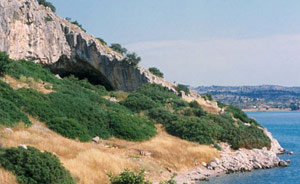
Evidence of very early settlement on the Greek Islands comes from the Franchthi cave, overlooking the Argolid Sea in the Peloponnese. Occupied from about 20,000 BCE through the Mesolithic and Neolithic periods, this cave contains some of the earliest evidence of agriculture in Greece.
Hunter gatherers were probably its first inhabitants, but from around 11,000 BCE non-native food, such as almonds and lentils appear, and obsidian items from this cave have been found on the island of Melos 80 miles away by sea. Even this early, these island peoples were involved in long-distance sea travel. Around 6000 BCE, evidence of domesticated animals and plants appears in the archaeological record at the cave, and large fish bones indicating deep sea fishing. The cave was apparently abandoned in about 3000 BCE.
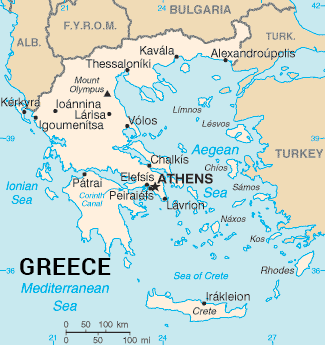
Greek Dark Age: Circa 1200 – Circa 800 BCE
The political and military collapse in Mycenean Greece around 1200 BCE was devastating. It is likely that a combination of events contributed to it: earthquakes, which were frequent in the region, drought due to climate change, the migrations of barbarians (these were foreigners – not barbarians in the way we now understand the word), plus invasion and civil war.
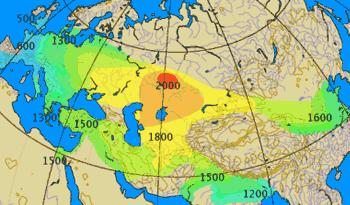
War in these times, meant maintaining hundreds of chariots and their associated horses to use as battle taxis and as a means of bearing drivers and archers. Armies also employed light armed infantry men, trained in the mountains and woods, who served kings and lords as mercenaries, and as “runners”, killing victims injured by the charioteers.
It seems likely that these javelin-throwing, fleet-footed soldiers, seeing their chance, decided to take things into their own hands. An orgy of slaughter, looting, and destruction may well have followed where cattle, women and wealth were plundered. The chariot’s inability to fight on uneven terrain, plus the shift to infantry, neutralized its use, not only in the Aegean, but in effect rendering the chariot an outmoded weapon over much of the ancient world, after 400 years of supremacy.
The success of war thereafter depended on every man playing his part, an attitude that may well have stimulated a spirit of independence and of individual responsibility – useful prerequisites for the social and political changes that would eventually follow.
All the palaces, except Athens, were sacked and burned. Since these citadels held all the arts, written records, and the riches associated with their long-distance trade, a period of illiteracy and poverty took over with no written records or monuments to tell us much. The rise of servile populations, workers, farmers etc., caused additional internal upheaval. Dorian Greeks, who had been a part of the lower classes, the serfs, farmers and laborers of the Mycenaean world, may also have been joined by others from north-western Greece, Macedonia and Epirus. In any case, the inhabitants were overwhelmed and the entire social order collapsed.
From about 1200 BCE, the Myceneaen population had virtually disappeared from the region. Some people possibly hid up in the hills and mountains, perhaps becoming herdsmen, using temporary housing, wearing animal skins and owning little, they left us no archeological trace. Some fled overseas to western Anatolia, or along the shores of the eastern Mediterranean, some may have joined itinerant fighters such as the Sea Peoples.
From about 1200 BCE, judging from archaeological sites, the Myceneaen population had virtually disappeared from the region.
Anarchy and poverty spread over the entire Greek world, which virtually obliterated any memories of the two civilizations: the Minoans and Mycenaeans. Things were so extreme that the survivors were left with at best a dreamlike memory of their past.
But this complete break with the past and with all connection to it eventually would enable the Greeks to develop a new civilization that will move out in directions quite different from elsewhere in the region.
The Greek kingdoms in the Aegean probably suffered most because they were in the most remote area of the region.
Archaic Greece: Emerging from the Dark Age 800–500 BCE
By 900 BCE Greek society was gradually re-establishing itself, structured around a smaller social unit called an Oikos, each dominated by the head of the household or clan, and housing his family, servants, retainers, slaves and livestock. Eventually these Oikoi expanded into villages and towns. With their expansion came the problem of who was in charge. Statis or conflict was a continuous and ever present condition in the steps towards the polis or city-state – the political community which would become characteristic of Greece.
Fertile land was limited in Greece, which was, for the most part, mountainous and rocky, and this added to the feeling of stress during these chaotic times. A new type of agriculture emerged with fiercely independent farmers developing less desirable lands with a mixed agriculture, better adapted to conditions than the more centralized agriculture of the aristocratic estates. These farmers would collectively play a pivotal role in the formation of the new Greek society.
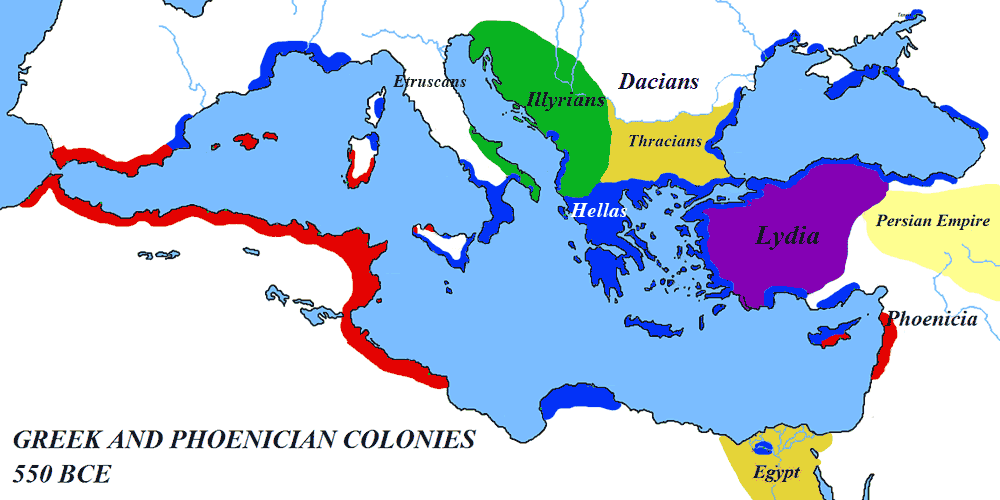
Colonization became a safety valve. From approximately 1000 BCE onwards, young Greeks were sent to colonize territories in order to acquire rich fertile land. In addition Greeks established trade routes where they sailed looking for resources, and colonies were eventually established at various coastal points, not only around the Aegean, but around the Black Sea and the western Mediterranean, as far as Massilia in southern France (Marseilles), Emporiae in Spain, Cyrene in Northern Africa, and Olbia – “wealthy” – in southern Ukraine.
One document gives us insight into the Greeks motivation to colonize: In Homer’s Odyssey Odysseus relates his adventures and tells of visiting the Cyclops and gouging out his eye – the passage includes the description in the quote that opens this article. He describes what it was like to visit Cyclops’ land. The territory was lawless run by barbaric people with no sense of community no “ágora” – meeting place. Each man had a separate law for his own family. But, just offshore was the most glorious island just crying out to be colonized and used, and only goats occupied it. “For this island is by no means poor, but would carry any crop in due season. There are rich well-watered meadows there, along the shore of the grey sea, where vines would never fail. There is level land for the plough with soil so rich they could reap a dense harvest in season.”
The audiences of this Homeric poem may well have thought how wonderful it would be to go to that rich land.
The Greeks were influenced by those cultures with which they came in touch and to these influences they added their own innovations and improvements. Egyptian influence can be seen in Greek architecture and sculpture, yet Greek pillars are more slender and have more graceful lines, their statues are more life-like than the stiff formal Egyptian models.
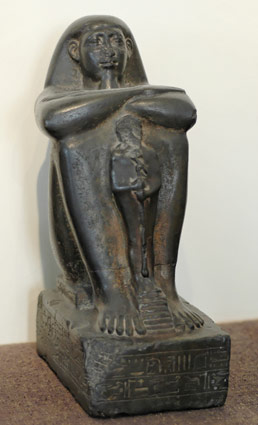
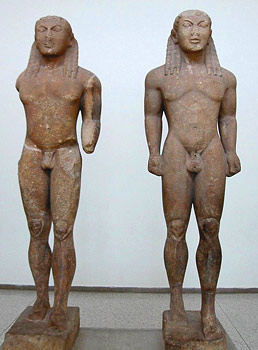

From the Phoenicians, the Greeks took the written pictograms of words like “alef” and “bet” that meant “ox” and “house” and simply kept the sound: alef – Alpha = the sound A, bet – beta = the sound B, etc. Thus, in 725 BCE when writing comes back to the Greeks, it is no longer Linear B of the Greek Mycenaean period, but what we now know as the “alphabet.” This was probably one of the greatest developments that contributed to modern thinking. For the first time in history the elements of writing were decoupled from their meaning, so that using only 24–27 phonetic letters combined into any number of meaningful units, the Greeks were able to write about everything they saw, experienced and thought of in their own language.
History According to the Storytellers
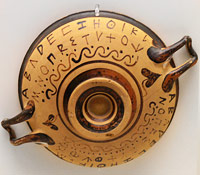
Although we know little about this time, we know a great deal more than the Greeks did. But this, in a sense, left the Greek survivors free from the constraints of evidentiary history, to turn instead to the world of their traditional storytellers.
From about 1000 BCE onwards wandering poets sang cycles of formulaic, heroic tales, sometimes with subtle changes to suit specific situations. These oral recitations would entertain communities, in particular the wealthiest people. They were so long that they would take days to complete. They created a world connecting the Greeks to an heroic past and became the center of their cultural tradition. The Greeks had no sacred text, but for them, these epics took on a stature equivalent to it. The epic poems of Homer were among the first things they wrote down around 725 BCE.
These Homeric poems became the basis of moral behavior and were taught to young men throughout Greece. This was their heroic past. These mytho-poetic stories finally became much more for the Greeks than just a history, they embodied who they were. Children were taught Homer, not history, and so through myth, memory and poetry the Greeks created a unique identity and culture. They told of heroes who were twice as strong, powerful and steadfast as any normal person and this ideal became the foundation on which a Greek man would base himself. These epics established a code of honor based on shame – where valor and the adherence to duty in the face of overwhelming odds were all important. Heroism is all the greater because a Greek will fight until the end; even though he loses, he will not lose his honor: “If I stay and die Sparta loses nothing, if I run away and live, both Sparta and I will be dishonored.”
Children were taught Homer, not history, and so through myth, memory and poetry the Greeks created a unique identity and culture.
The two extant Homeric epics (there were originally ten) both concern the great defining moment of Greek culture, the Trojan War. Whether or not this war really took place, or occurred as the Greeks narrate it, we don’t know. A war did take place at the time around a city that quite likely was Troy, and that city was utterly destroyed, but beyond that we know little. Nevertheless, we know that the Greeks saw the Trojan War as the first moment in history when they came together as one people with a common purpose. This unification, myth or not, gave the later Greeks a sense of national and cultural identity. If you spoke Greek and had the same epic values, it meant that you were the same as all the other Greek-speaking peoples.
To these early Greeks actions were of paramount importance. The world was a place of conflict and difficulty where human value and meaning are measured by effective action.
There are two very important words repeatedly used throughout the Homeric epics: honor (timé) and virtue or greatness (areté). The latter term is perhaps the most reiterated cultural and moral value in Ancient Greece and means something like achieving, morally and otherwise, your greatest potential as a human being. The reward for great honor and virtue is fame (kleos), which is what guarantees meaning and value to one’s life. Dying without fame (akleos) is generally considered a disaster, and the warriors of the Homeric epics commit the most outrageous deeds to avoid dying in obscurity or infamy (witness Odysseus’s absurd insistence on telling Polyphemos his name even though this will bring disaster on him and his men).
Greek Religious Life
As in other cultures, the development of Greek religion focused around those aspects of Greek life that were of primary importance, for the Greeks it was the resolution of conflict or statis, the development of community, and individual excellence. Greek mythological stories are about conflict, yet, as we have seen in Homer’s epic, veneration of their mythical heroes bound the Greeks together around a glorious past. Greek religion was part of the attempt to reinforce a common sense of purpose, civic cohesion, and community.
Like other pre-Axial cultures, Greeks believed in a pantheon of Gods, many inherited from their Minoan and Mycenaean predecessors. They ruled over various aspects of natural, social, and political life and were involved in everything they did.
To the Greeks religion was not doctrinal, but a way of living. There was no sacred text, so there could be no profession of faith measured against it. Faith was a private matter, religion was a public affair enacted for the good of all. Each city-state had its own patron deity who influenced how local citizens saw themselves and understood their relationship to outsiders. Communities adapted the myths of their patron deity to suit their purposes, so stories about Athena, (originally a Minoan deity) the patron goddess of Athens were told in one way in Athens and in another outside her boundaries, in Corinth or Sparta, for example.
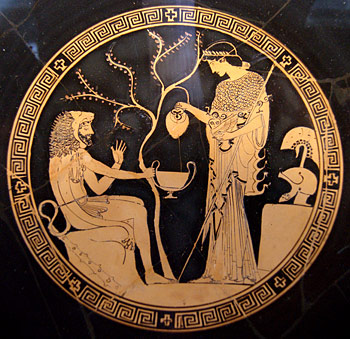
Religion and politics were inextricable aspects of Greek life, adherence to traditional rites and to the civic and social expectations of the city-state demonstrated that one belonged. Gods presided over every aspect of life and nature and if one wanted their help, they required sacrifice. This was especially true on the political level: no political authority could be exercised absent the appropriate ritual sacrifices. Sacrifices were the central event around which festivals, athletics, oracles, and all other events honoring the gods were focused. A sacrificial ceremony was a communal affair, not only were all of the members of the community there, eating together and bonding socially, the Greeks believed that the gods participated directly as well.
Greek legends, myths and rituals were performed in public and attended as part of a Greek’s religious obligation, providing cohesiveness to the political community. As Greece prospered, so did their religious rituals. Wealthier cities began to host larger and larger celebrations that incorporated an ever wider audience. There was always a religious element to these celebrations, even if the dominant theme appeared to be something else – such as the athletic competitions at the Olympics.
Cult mysteries provided experiences of a more personal nature, even though these were never enacted in solitude. For example, the Eleusinian mystery cult which had initiatory rituals that Greeks experienced as transformative; the mystery cult of Dionysus too, enabled worshippers to experience divine possession, and the knowledge that the god was truly among them.
“The origin of the mystery ceremonies does seem to be India: or, at least, the place and time when the Brahman priesthood started its initiation. The ceremonies were based upon the Hindu myths but the procedure followed in training by the aspirant is strikingly similar in Egypt. And Egypt profoundly influenced Greece.” says Arkon Daraul in Secret Societies.
Greek Political Life
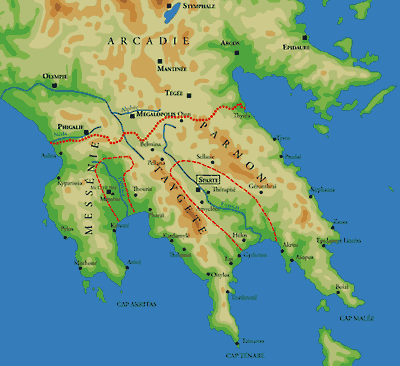
From the eighth century, political development focused around two entities. First, the older tribal-state or ethnos, established mostly in mainland Greece, consisted of agricultural villages and settlements united by a common religious temple or site and governed by a major landowner or by a king (basileus). Second, what became known as the city-state or polis evolved around hilltop centers (acropolis) that were at some time in their history dedicated to specific gods. Every ethnos or polis was a politically separate and independent entity, frequently experiencing internal strife, disunity, and in constant statis (conflict) with those around it.
Delphi, Olympia, and the Panhellenic Games
The oracle of Apollo at Delphi and the Olympic games were two institutions of great importance in addressing these conflicts by stressing the community’s common Greek identity. They were open to any individual identified as Greek, and both fundamentally helped to shape what it meant to be a Greek.

The sanctuary of Apollo at Delphi was a sacred space that included both a temple and sacrificial altar to Apollo and temples for other gods, plus treasuries where dedications and offerings were brought by individuals and states. Administered by the priestly clans of Delphi in conjunction with a religious confederation of Greek states, Delphi was politically neutral, so it attracted supplicants from all over the Greek world. As Greek colonies and city-states grew, it came to play the crucial role of mediator in Greek affairs, the oracle offering judgments in disputes and settling quarrels over borders, etc.
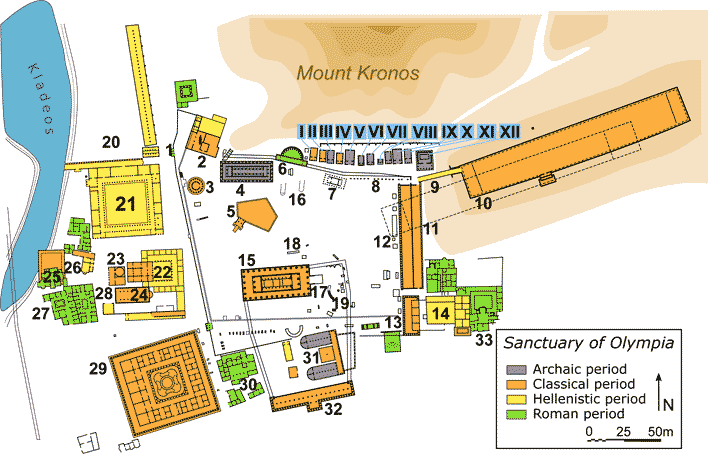
The Olympic Games, held in honor of Zeus, were the first of a series of four Panhellenic contests, founded in 776 BCE, they took place every four years. The others were: the Pythian Games – held every four years, near Delphi, in honor of Apollo, the Nemean Games – held every two years, near Nemea, also in honor of Zeus, and the Isthmian Games – held every two years, near Corinth, in honor of Poseidon.
The argon or contest was at the center of life for the Greeks in their striving towards individual excellence, and, at the same time, prepared them both physically and mentally for conflict. These games provided a socially cohesive way in which they could compete, excel and prove themselves heroes in the Homeric sense.
Olympia was a sanctuary for the God Zeus and as such was also neutral. Games held there were protected by a Sacred Truce that ended all interstate warfare during the period of the games, so that all Greek athletes could travel there and compete. Olympia’s prestige matched Delphi’s. Originally individual aristocrats competed on their own behalf, but as city states grew more powerful, these Games became a legitimate venue for the expression of the competitiveness that existed between city-states which sent their best athletes to represent them.
Participation in the games confirmed ones Greekness, Greeks became Greek by competing with other Greeks. As with Homeric heroes, the winners were commemorated in verse and honored with “undying glory” in odes that connected them to the heroes of old.
Greek Government
The most common form of government in the polis was oligarchy, or “rule by a few.” The oligarchs were almost always drawn from the noble classes or from the wealthiest citizens of the state, but a variety of oligarchic forms were invented in the eighth century. These included having the members chosen by lot, having them elected, or rotating the oligarchy among members of a certain class. The oligarchs most often ruled absolutely and had many of the powers granted to a king.
Fifth century BCE Greece was one of four world regions where great Axial age thinkers began to forge a more enlightened morality of personal responsibility.
Each city-state attempted to handle this statis in its own way. The most extreme was Sparta. In wars that resulted in the conquest and enslavement of the Messenians in 650-600 BCE, the Spartans alone of the Ancient Greeks took a land and peoples by force. Such an act had no precedent in the ancient Greek world. Spartan life became rigid and conservative, Spartans lived in constant fear of their captured neighbors who became subjugated ‘helots,’ farming and laboring for their Spartan masters. Every Spartan male citizen became a soldier of the Spartan Army. Even the elite were obliged to live and train as soldiers, which at least diffused any conflict between rich and poor. In contrast, Athens united the entire region of Attica under its rule and made all its subjects Athenian citizens.
The Hoplites and Free Speech
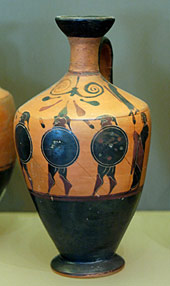
From 650–350 BCE city-states relied on ordinary citizens to fight when necessary. They were expected to equip themselves and since swords, shields and armor were quite expensive, this likely applied only to the relatively successful farmer or craftsman. Most would join the Hoplite infantry, an experience which helped to transform the hierarchical structure of Greek society.
When farmers fought alongside noblemen in a Hoplite phalynx, they were transformed into one savage killing machine. They were equals, all totally dependent upon each other for their safety and success in battle. After such experiences, farmers no longer saw themselves as separate and subservient. They were all noble warriors and would soon demand their rights as citizens, forcing the pace towards eventual democracy.
In the late seventh century, free speech, originally the privilege of the nobles, became the right of all Hoplite soldiers. All Hoplites were permitted to challenge the battle plan and contribute practical solutions. They spoke in practical, logical and solution-oriented terms, a language called LOGOS that was quite different from that used in mythical and poetic oratory.
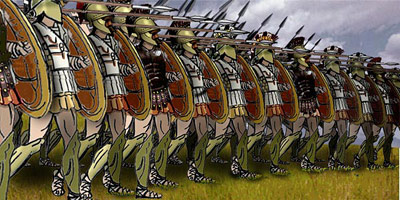

Watch: Secrets Of The Aegean Apocalypse
Around 1,200 BC, an ancient Armageddon destroyed nearly every known civilization. What could have caused it? The theories are many, but most now include one mysterious and massively destructive factor – a force only the Egyptians survived to name: The Sea People.

God 4.0
On the Nature of Higher Consciousness and the Experience Called “God”
By Robert Ornstein with Sally Ornstein
Review by Denise Winn
Contributing Writer
Countless research findings reveal the existence of a second network of cognition that transcends everyday consciousness. It is what people have tried to activate, from the earliest shaman-sages to Moses 3,500 years ago, to Jesus 2,000 years ago, to Muhammad 1,400 years ago, all the way up to the myriad of contemporary seekers. Read more
- Shop placeholder
- Product Categories
- Discussion Guide: Empathy, Connection, and Global Health and Wealth in the Wake of Covid
- The Legend of Hatim al Ta’i
- Common Heritage
- The Human Journey Blog
- Privacy Policy
- Watch & Listen
- Venus of Willendorf: Early Cultural Icon?
- Test translation
- Explore Your Interests
- For Further Reading
- Pathways to Key Insights
- Contact
- Evolutionary, Historical, and Contemporary Perspectives
- Terms of Use
- Contributors
- About Us
- 27 books of the New Testament
- Journey of the Human Mind
- In the News
- Home
- God 4.0
